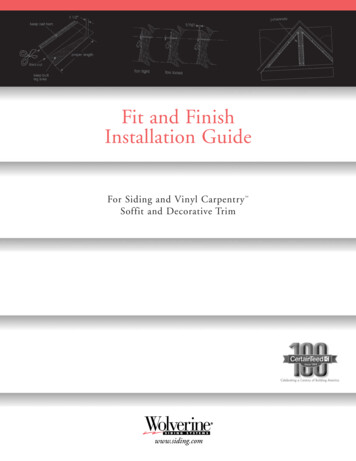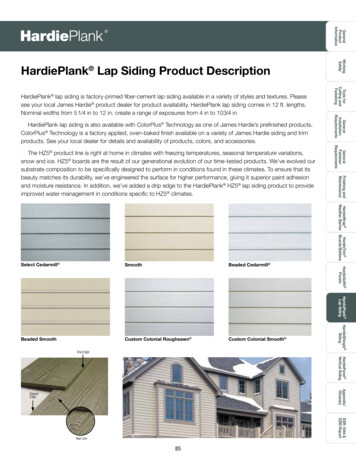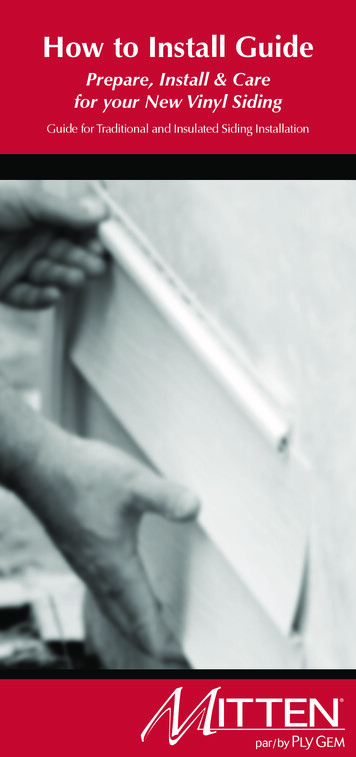
Transcription
STEEL SIDING INSTALLATION MANUAL
ABOUT THIS MANUALWe suggest you review this entire manual before beginning yourinstallation. As you read, you will want to refer to the drawing on page 8 tofamiliarize yourself with commonly used industry terms. You may also wishto cross-check various sections of the manual as you read.Installing metal siding can be fairly simple if you follow the instructionsin this manual. Each section is designed to guide you through every stepof the job by providing practical advice based on years of industry practiceand experience. Please note, however, that this manual is designed to helpthe qualified siding installer; it is not intended for use by homeowners.The techniques discussed in this manual are illustrative of the basicprocedures. They are not intended to be fully exhaustive and definitive.Other methods may be used by qualified installers with equal success.The best method is dependent on the specific construction of the buildingbeing worked on, the brand and type of siding used and the particularskills of the individual applicator.Although this manual is based on the best information and experiencecurrently available in the industry, Klauer Manufacturing Company doesnot make any representation or warranty, express or implied (whether ofmerchantability or of fitness for a particular use or purpose) with respectto any tools, material, techniques or procedures referred to herein.Always remember to use licensed contractors who understand localbuilding codes as these codes may vary from one region to another.Handle siding with care. Steel siding has sharp edges. Make sure productis stored flat with support under the length of box. Tilt the box 90 degreeson its side during transport. For installation, open the entire box andlift pieces rather than slide them to prevent scratching. Always keepsiding material dry and protected. See Warranty card for more care andmaintenance instructions. See page 18 for instructions on safe cuttingprocedures.Inspect siding upon receipt. Damaged material should be reported as soonas possible to the place of purchase. Also inspect after the installationof the first three square of siding. If a material defect is suspected, stopinstallation and report the concern to the place of purchase or contactKlauer Customer Service at (800) 896-3904.2
CONTENTSplanninggetting startedtriminstallation4Accessories5Tools required6Equipment7Material estimating8Nomenclature9Preparation10Furring and installation techniques12Base chalk line13Inside corner14Outside corner15Starter strip16Window and door trim17Window and door trim – Gable end trim18Cutting procedures19Installing the siding– First course– Lapping– Overlapping– Expansion and contraction– Proper staggering of panels– Improper staggering of panels22Nailing and stapling23Panels at windows and doors25Fitting at gable ends26Fitting under eaves27Vertical siding29Caulking and cleanupspecial situations30Repairs and miscellaneous– Replacement of damaged panel– Transitions– Vertical over horizontal– Horizontal over vertical– Short panels between openings– Starter-strip application in difficult conditionsfinal touches32Soffit and fascia34Rainware36Estimate worksheetworksheet3
ACCESSORIESSTARTER STRIPBase-line accessory which secures the first course of siding to the wall. Used withhorizontal and vertical siding. Nail 12" O.C. (on center).J-CHANNELUsed for receiving siding on all sides of windows and doors, at rake edges of gablesand in other miscellaneous situations. Deeper J-channels are for insulated siding, andnarrower J-channels for non-insulated siding. Nailed 12" O.C.OUTSIDE CORNER BASEProvides neat appearance outside corners for horizontal and vertical sidings. Receivessiding from both sides. Deeper bases are used with insulated siding, and narrowerbases with non-insulated siding. Both flanges are nailed 12" O.C. Available in 3/4"and 1-1/8".OUTSIDE CORNER CAPSnaps in place when siding installation has been completed.SILL TRIMUsed to finish off (“trim”) jobsite cuts on siding, as under windows, at eaves, andat porch door locations. May also be used to receive vertical siding at corners andwindow jambs. The snap-lock design allows siding to be notched and locked intoplace without face nailing.4
TOOLS REQUIREDThe siding applicator’s job can be made much easier with the proper tools.ESSENTIAL TOOLS1.Carpenter’s Metal Square2.Carpenter’s Folding Rule3.2' Level (minimum)4.Caulking Gun5.Steel Measuring Tape6.Fine-Tooth File7.Power Saw (preferably metal cutting saw)*8.Claw Hammer9.Chalk Line10.Screwdriver(s)11.Pliers12.Tin Snips Duckbill-Type13.Aviation Shears Double-Acting14.Carpenter’s Saw Crosscut15.Safety Goggles16.Steel Awl17.Metal-Cutting Hacksaw (fine-tooth w/ 24 teeth per inch)18.Utility Knife19.Line Level20.Putty Knife 3"21.Hard Hat22.Electric Nibbler (optional)23.Siding Cutter (optional)24.Snap-Lock Punch ToolADDITIONAL MATERIALS REQUIRED:1.Gutter Seal2.Trim Sheet Available in 24" Width3.T ouch-Up Paint (colors to match siding – for vents, kitchen fans, servicecables, etc.)4.Caulking (preferably volatile organic compound [VOC] compliant)5.H ot-Dipped Galvanized Steel Nails: 1-1/2" for general use, 2" for residing,2-1/2" (or more) through insulated siding into soft sheathing, and 1" to1-1/2" trim nails (colored to match siding)Note:A minimum penetration of 3/4", excluding point of nail, into solid lumber is requiredfor nailing to be effective with plain shank nails. Ring or screw shank nails could beused through 1/2" plywood for similar effectiveness.* For steel: A power saw can be used on steel if equipped with an approved titaniumcarbide-tip blade. Consult siding manufacturer.5
EQUIPMENTLADDERS AND SCAFFOLDSProper ladders and scaffolds are necessary. A pump jack is widely used to provide aworking platform. The posts upon which the pump jack moves are normally two 2-by4s nailed together to form a 4-by-4 post.With a pump-jack platform, the distance from the building facade remains the samefrom the bottom to the top. Exact specifications on spacing dimensions, planking,permissible heights and loads, etc., are contained in the OSHA Construction Safetyand Health Regulations under section 1926.450 and 1926.451 covering ladders andpump jacks. Contact your local OSHA office.CUTTING TABLEFor a more efficient and professional operation, specialized equipment may beneeded. A valuable timesaver is the portable cutoff or trim table, which allows astandard portable circular power saw to be mounted in a carrier and set aside toavoid damaging the siding. These tools can help measure and crosscut, as well asmake miter and bevel cuts for siding, soffit and trim. The units are constructed oflightweight aluminum and can be easily set up on the jobsite by one person.PORTABLE BRAKEFor jobsite bending of custom-trim sections, such as fascia and sill trim and windowcasing, a portable metal-bending machine (brake) is extremely useful. Utilizing whiteor colored-coil stock, precise multiple bends can be accomplished. These machinesare lightweight for easy transport to the jobsite and setup in place. Various sizes andbrake styles are available.6
MATERIAL ESTIMATINGSIDINGACCESSORIESIn order to determine the amount of sidingneeded to cover a house, the measuring processcan be reduced to simple steps. Virtuallyall houses contain a series of rectangles ortriangles, or a combination of both, regardlessof how divided the face of a wall is by windowsand doors (Fig. 1). Using the Fig. 2 formulabelow, measure the height (excluding gables)and width of each side of the house (includingwindows), and arrive at the area in square feet.Now compute the gable triangle areas using theFig. 3 formula below and total them. Windowand door areas are generally not deducted, asfiguring them in the wall area will allow forwaste. If window and door areas are extremelylarge (such as garage or sliding glass doors),some deduction can be made. Dormers andgables are traditionally prone to material wastedue to cutting and fitting; to compensate, add1' in height to the original measurements. Forvertical siding, allow approximately 20 percentof additional material for waste.To determine the amount of starter strip required,measure the lineal feet around the entire base ofthe building to be covered. For corner posts andaccessories, also measure in lineal footage andadd a factor of approximately 10 percent to allowfor waste.1Note:Also see siding material estimating worksheeton back cover.2345677
NOMENCLATUREReferences will be made throughout this manual to various partsand pieces associated with house construction. The drawing belowidentifies the most common descriptive terms and shows theirlocation on a typical RTICAL SIDINGOUTSIDECORNERINSIDE CORNEREAVEBAY WINDOWHORIZONTALSIDINGSOFFITFASCIA8
PREPARATIONSURFACE PREPARATIONThe quality of the finished job depends on the proper preparation of the work surface.Check for low places in the plane of the wall and build (shim) out if required. Preparethe entire building a few courses at a time. Securely nail all loose boards and woodtrim. Replace any rotted boards. Scrape away old paint buildup, caulking andhardened putty, especially around windows and doors where it might interfere withthe positioning of new trim. New caulk should be applied to prevent air and waterinfiltration.Note:Uneven and/or out-of-plum surfaces can create waves or oil-canning as well asirregular shadow patterns in siding panels.REMOVE DOWNSPOUTS / TIE BACK SHRUBSRemove downspouts and other items that would interfere with installation of newsiding. Tie back shrubbery and trees from the base of the building to avoid damageto the landscaping.WINDOWSILL PREPARATIONWindowsill extensions may be cut off so J-channel trim can be installed flush withwindow casings.To maintain the original window design, coil stock can be custom-formed around thesill instead of cutting away the extensions.9
FURRING AND INSTALLATION TECHNIQUESWOOD FURRINGFurring is the process of building out from the wall surface to provide a smooth, evenbase for nailing on the new siding. Lath strips 3/8" thick are most commonly used.Lumber strips measuring 1" x 3" are often used over brick and masonry. Furring isnot usually necessary in new construction, but older homes often have uneven walls,and furring out, or shimming, low spots can help prevent a wavy appearance to theinstalled siding. Insulation value can be added by furring out an entire wall (seepage 13). Furring should be installed 16" vertically on center for horizontal siding,and the air space at the base of the siding should be closed off with strips appliedhorizontally. Window, door, gable and eave trim may have to be built out to match thethickness of the wall furring.VERTICAL SIDINGFurring for vertical siding is essentially the same as for horizontal siding, exceptthe wood strips are securely nailed horizontally into structural lumber on 16" to24" centers. When using 1" x 3" furring, be sure to check what effect the additionalthickness might have on the trim.UNDERLAYMENTFanfold 1/4–3/8" thickHousewrapSiding is to be installed directly over properly installed underlayment. We specify thatan underlayment be used on all applications prior to the installation of the siding. Wealso recommend the following:a.A ll seams and channeling are to be taped to help prevent air and waterinfiltration.b. All outside and inside corners should be wrapped continuously.c.U nderlayment is to be installed over roof or brick flashing, and then taped tohelp prevent water and air infiltration.d.U nderlayment is to cover from the top to the bottom of the wall including allgables.e. hen using housewrap, seams are to be overlapped a minimum of 1' andWthen taped.f. Use plastic-cap fasteners to attach the fanfold underlayment to the wall.g.P rior to the installation of siding on a retro project, the fanfold must be appliedover the top of the existing siding so there is a flat surface to apply the newsiding onto.h.The fanfold is applied with the foil facing inward.Note:Whenever installing any type of insulation or housewrap products, follow themanufacturer’s installation instructions.Klauer Manufacturing Company does not recommend installing drop-in foam backerfor any of its manufactured siding panels.10
FURRING AND INSTALLATION TECHNIQUESWINDOW AND DOOR BUILD-OUTSome trim build-out may be required at windows and doors to maintain the originalappearance of the house when using furring strips or underlayment board, particularlyif it is more than 1/2" thick. Thicker furring and underlayment generally provide addedinsulation value and are usually a good investment for the homeowner, particularlyif the home is non-insulated. When estimating the labor and materials required forinstalling furring and underlayment, be sure to include window and door build-out.Longer siding nails will be needed to compensate for the added thickness of theinsulation board.UNDERSILL FURRINGBuilding out below window sills is often required in order to maintain the correctslope angle if a siding panel needs to be cut less than full height. The exact thicknessrequired will be apparent when the siding courses have progressed up the wall andreached this point (see page 23).UNDEREAVE FURRINGFor the same reason, furring is usually required to maintain the correct slope angle ofthe last panel where it terminates at the eave. This panel usually has to be cut to lessthan full height, thus requiring backup furring and a special piece of trim for capping(see page 26).11
BASE CHALK LINESTRAIGHT LINEThe suggested procedure is to measure equal distances downward from the eavesand/or windows. This ensures that the siding appears parallel with the eaves, soffitand windows, regardless of any actual settling of the house from true level.Note:The key element in a successful siding installation is establishing a straight referenceline upon which to start the first course of siding.CHALK LINESFind the lowest corner of the house and drive a nail about 10" above it, or enough toclear the height of a full siding panel. Stretch a taut chalk line from this corner to asimilar nail installed at another corner. Reset this line based upon measurementsfrom points of equal dimension down from eaves or windows. Repeat this procedureon all sides of the house until the chalk lines meet at all corners. Before snappingchalk lines, check for straightness. Be alert to sag in the middle, particularly if theline is more than 20' long. If preferred, lines may be left in place while installing thestarter strip, as long as they are checked periodically for excess sag.LEVELIf the house is reasonably level, an alternative is to use a level to set the chalk lineapproximately 2" (or the width of the starter strip) from the lowest point of the oldsiding, and locate the top of the starter strip to that line. Be careful when using astandard carpenter’s level because progressive measurements may increase thepossibility of error. The level should be at least 2' long, and preferably longer. Takea level reading at the center of the chalk line for best results.12
INSIDE CORNERINSTALLATIONTwo J-channels at right angles may also be used as an inside corner. A bead ofcaulking will assist in preventing water penetration at the junction. Deeper ornarrower J-channel may be required, depending on the type of siding (insulated ornon-insulated). Set the J-channel full length in the corner, reaching from 1/4" belowthe bottom of the starter strip up to the eave or gable trim. Nail approximately every12" on both flanges. Make sure the J-channel is set straight and true. Flanges shouldbe nailed securely to the adjoining wall, but do not overdrive nails so as to causedistortion.EXPANSION ALLOWANCEButt the siding into the corner and nail it into place to allow approximately 1/16"space between the J-channel and the siding for expansion purposes. (See page 20for more information on expansion and contraction requirements.)13
OUTSIDE CORNERBASENail every 12" in nail slots on both sides of the corner base. Make sure bothsides are securely nailed, but avoid the distortion caused by overdriving nails.If insulation is being used, wide bases may be needed. The base should extend1/4" below the starter strip.CAPThe outside corner post produces a trim appearance. Set a full-length piece over thecorner base running from 1/4" below the bottom of the starter strip to the underside ofthe eave. If a longer corner cap is needed, overlap corner post sections with the upperpiece outside.INSTALLATIONThe outside corner post produces a trim appearance and will accommodate thegreatest variety of siding types.Set a full-length piece over the outside corner base running from 1/4" below thebottom of the starter strip to the underside of the eave. Fix the cap to the base witha screw. If a longer corner post is needed, overlap corner post sections with the upperpiece outside.14
STARTER STRIPHORIZONTAL SIDINGUsing the chalk line previously established as a guide, take measurements at equaldistances (see “A” in diagram) and install starter strip all the way around the bottomof the building. If insulated siding is used, the starter strip should be furred out thethickness of the backer (see page 28). It is extremely important that the starter stripbe straight and meets accurately at all corners as it will determine the line of allinstalled siding panels. Where hollows occur in the original wall surface, shim outbehind the starter strip to prevent a wavy appearance of the finished siding.VERTICAL SIDINGA plumb line should be used when applying starter strip in a vertical position (seepage 27).NAILINGThe starter strip should overlap the corner-base flanges to help reduce air and waterinfiltration. Space nails not more than 8" apart to securely fasten the starter strip.Nail the starter strip as low as possible, being careful not to bend or distort it. Do notoverdrive nails. Cutting lengths of starter strip is best accomplished with tin snips.Butt sections together.ALTERNATIVESStarter strip may not work in all situations. J-channels or sill trim may work betterin starting siding courses over garage doors and porches or above brick, for example.Situations must be handled on an individual basis as they occur (see page 31).15
WINDOW AND DOOR TRIMCOIL STOCKFor a superior remodeling job and freedom from maintenance, the original windowsills and casings can be covered with aluminum- or steel-coil stock bent to fit on thejobsite.Sometimes window and door casings need to be built out to retain or improve theoriginal appearance of the house. To do this, nail appropriate lengths and thicknessesof good-quality lumber securely to existing window casings. Remove storm windowsbefore covering casings with coil-stock sections custom-formed on the jobsite.Forming coil sections to fit window and door casings is done with a portable brakeas follows:1.S ill Cover – Form trim to the dimensions of the wood sill being covered.For flashing purposes, snip and fold the upright tabs at the jamblocations and sill ends as shown. Install with small-head trim nailsand/or adhesive.2.C asing Cover – Form casing trim to the dimensions of the wood jambbeing covered. Install over the vertical flashing tabs of the sill-cover trim.Fasten in place same as above.3. indow-Head Cover – Form to the dimensions of the wood head beingWcovered. Miter corners on both sides as shown. Install so as to lap overthe casing-trim pieces and fasten in place.4.C aulk – Apply where necessary to prevent water penetration behind thetrim pieces.TWO-PIECE SILLIf there is a step in the wood sill, it can best be covered by bending two separate sillcover pieces as shown. Let the flanges lap over for best water runoff.SILL ENDSBy using tin snips and bending flanges, the old sill ends can be boxed-in to provide aneat appearance and prevent water penetration.Note:Care must be exercised in placing aluminum or steel in contact with materials suchas dissimilar metals, concrete, stucco, asbestos siding, pressure/pre-treated lumber,masonry or corrosive nonmetallic materials that might become repeatedly wet.16
WINDOW AND DOOR TRIM – GABLE END TRIMTRIMJ-channel is used around windows and doors to receive siding. Side J-channelmembers are cut longer than the height of the window or door and notched at the topas shown. Notch the top J-channel member at a 45 angle and bend the tab down toprovide flashing over side members. Caulking may be used behind J-channel membersto prevent water infiltration between the window and the channel. Do not caulk thesiding inside of the J-channel to attempt to seal it.FLASHINGTo prevent water from getting behind the siding, a flashing piece may be cut from coilstock, slipped under the base of the side J-channel members and positioned so as tolap over the top lock of the panel below (see illustration).GABLE ENDSBefore applying siding, J-channel should be installed to receive siding at the gableends. Where the left and right sections meet at the gable peak, let one of the sectionsbutt into the peak with the other section overlapping. A miter cut should be made onthe face flange of this piece to improve its appearance. All old paint buildup shouldbe removed before installing J-channels. Nail every 12" to 16".17
CUTTING PROCEDURESPOWER SAW STEELTypically, steel should not be cut using any heat-generating device such as an electriccircular saw or jigsaw – to do so may destroy the protective galvanized coating anddamage the siding. However, a power saw (preferably metal) can be used on steel ifit is equipped with an approved titanium carbide-tipped saw blade.CAUTION: Safety glasses should be worn at all timeswhile operating a power saw.TIN SNIPS STEELIndividual panels can be cut with tin snips. Start by drawing a line across the panelusing a square. Begin cutting at the top lock first and continue toward the bottomof the panel. Break the panel across the butt edge and snip through the bottom lock.Use a screwdriver to reopen the lock, which may become flattened by tin snips (seedrawing). Aviation shears are sometimes used to cut the top and bottom locks, anda utility knife can score and break the face of the panel. For straight cuts, the bestchoice is duckbill snips.SIDING CUTTER STEELUsing a guillotine-type cutting device designed to cut at vertical right angles to sidingis the preferred method for making straight cuts without damaging galvanizedcoating. Interchangeable blades for cutting 4", 5" and 8" profiles are available. Seeyour dealer for more information.NIBBLER STEELAn electric punch-action cutter is best for making straight, curved or circular cuts.18
INSTALLING THE SIDINGFIRST COURSEExtra care must be taken when applying the first course of siding because itestablishes the base for all other courses. Apply the panel by hooking the bottomlock into the interlock bead of the starter strip, making sure the lock is engaged.Do not force or jam it, which might cause distortion of the panel and result in anundesirable shadow line. Double-check for continuous locking along the panel andfor alignment at the corners before proceeding. The first course should be installeda minimum of 6" from the ground.At the corner bases, first slide the panel into the recess, then exert upward pressureto lock the panel into place along its entire length. Allow clearance for expansion asnecessary (see page 20). Panels must be hung with nails through the center of thefactory-slotted holes every 16" to 24" along the entire length. Nails must be driveninto sound lumber, such as 3/4" penetration into house framing with plain shanknails or through 1/2" plywood with screw or ring shank nails.19
INSTALLING THE SIDINGLAPPINGOn the sides of the building, start at the rear corner and work toward the front, so thatlapping will be away from the front and less noticeable. On the front of the building,start at the corners and work toward the entrance door for the same reason. Whenlapping, the factory-cut ends of panels should be on top of field-cut ends for the bestappearance.OVERLAPPINGPanels should overlap each other by approximately 1/2". A maximum of 5/8" and aminimum of 3/8" is a good rule of thumb. Thermal expansion requirements need tobe considered when overlapping panels (see below).1.Avoid short panel lengths of less than 24".2.Make sure factory-cut ends are always on top of field-cut ends.3.Start at the rear of the house and work toward the front.EXPANSION AND CONTRACTIONAllowance for expansion or contraction should be made when installing siding. Metalsiding will expand when heated and contract when cooled. Expansion can amount toapproximately 1/8" in a 10' length for every 100 of temperature change.If siding is installed in hot weather, the product is already warm and at least partly“expanded,” therefore less room will be required to allow for temperature expansion.If the product was stored in a hot or direct-sun area, the applicator should applythe siding panel against a corner base with a minimum clearance of 1/16". In coldweather, assuming the product was stored outside, the applicator should allowapproximately 1/8" of space between areas of possible restriction, such as at acorner base.Using this expansion and contraction “common sense,” the applicator should be ableto properly install products for the best appearance, and thus avoid the unnecessarywaves or buckles that could occur with temperature changes.20
INSTALLING THE SIDINGPROPER STAGGERING OF PANELSFor the best appearance, the staggering of joints should be well planned. Manyapplicators plan joining so that any two joints in a vertical line will be separated byat least two courses (see illustration). At a bare minimum, separate panel overlaps onthe next course by at least 2'. Joints should be avoided on panels directly above andbelow windows. Shorter pieces that result as work proceeds can be used for smallerareas around windows and doors.IMPROPER STAGGERING OF PANELSA poor arrangement of panel overlaps detracts from the appearance of the installation(see illustration).21
NAILING AND STAPLINGHANGING THE SIDINGDrive the nail snugly but not tightly through the center of the factory-slotted holeto within 1/32" of the nailing flange. The slots are elongated to permit the siding tocontract and expand freely. Siding nailed too tightly may not be able to move withtemperature changes, resulting in an unattractive wavy appearance. Expansionrequirements vary seasonally. An application installed in the hot summer requiresless allowance. An application installed in winter may require an expansion allowanceof as much as 1/8" per panel (see page 20).Note:Uneven and/or out-of-plum surfaces can create waves or oil-canning in siding panelsas well as irregular shadow patterns.NAILSWhen nailing siding and accessories, always use the correct size nails. Nails shouldbe driven straight and level, never slanted up or down so as to possibly causedistortion of the panel. Use 2" or longer nails for insulated siding and 1-1/2" orlonger nails for non-insulated siding as well as most trim accessories. A minimumpenetration of 3/4" into studs with plain shank nails or through 1/2" plywood withscrew shank nails is recommended. Where visible nails are required, use trim nailsthat match the siding or accessory.NAILING CENTERSSiding nails should be spaced approximately 16" O.C., for a maximum of 24", and notcloser than 6" from panel overlaps. Where low spots are encountered in a wall, drivethe nails on both sides of the low spot and allow the panel to float over it to maintaina straight shadow line. On new construction, nail into the studs 16" O.C. Do not skipstuds. In remodeling, when siding is installed over old wood, be sure that rotted orbroken boards are not used as the nailing base.PNEUMATIC STAPLERS/NAILERSPower fasteners are an accepted alternate method for installing siding. The samecare must be taken as when nailing by hand. Drive the fastener snugly but not tightlythrough the center of the factory-slotted hole to within 1/32" of the nailing flange.Fasteners must be corrosive resistant, such as cadmium coated or galvanized steel,and must be long enough to penetrate at least 3/4" into a solid substrate. The staplecrown should be a minimum width of 3/8". Check the gun, air pressure and yourtechnique on the first course, and make any necessary adjustments. Always followthe pneumatic power fastener manufacturer’s instructions for safe and proper useof the power gun.22
PANELS AT WINDOWS AND DOORSMEASURINGAs siding courses reach a window, a narrower panel will probably need to be cut tofit the space under the window opening so the panel will extend on both sides of theopening. Hold the panel in place to mark for the vertical cuts. Use a small piece ofscrap siding as a template, placing it next to the window and locking it into the panelbelow. Make a mark on this piece 1/4" below the sill height to allow clearance for thesill trim. Do the same on the other side of the window, since windows are not alwaysabsolutely level.CUTTINGVertical cuts should be made from the top edge of the panel with duckbills, tin snipsor a power saw.** A power saw can be used on steel if it is equipped with an approved titaniumcarbide-tipped saw blade.TRIMMING AND FURRINGThe raw-cut edge of the panel should be trimmed with a snap-lock finish trim theexact width of the sill. First determine if furring is required behind the cut edge tomaintain the slope angle with the adjacent panels. Nail the correct thickness offurring under the sill and install snap-lock finish trim over it, nailing up close underthe sill for a tight fit.INSTALLWith a snap-lock punching tool, punch slots every 12" to 16" along the top 1/4" ofthe panel. Slide the panel upward so as to engage the sill trim, the J-channels
Snaps in place when siding installation has been completed. sill trim Used to finish off ("trim") jobsite cuts on siding, as under windows, at eaves, and at porch door locations. May also be used to receive vertical siding at corners and window jambs. The snap-lock design allows siding to be notched and locked into place without face nailing.










